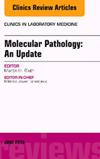肝素诱导的血小板减少检测。
IF 1.7
4区 医学
Q3 MEDICAL LABORATORY TECHNOLOGY
引用次数: 0
摘要
本文全面概述了肝素诱导的血小板减少症(HIT),重点介绍了实验室检测和自动化的优势。HIT 是一种由肝素暴露引起的危重病症,会导致血小板减少与血栓形成风险增加的矛盾结合。文章讨论了 HIT 的历史、临床表现、实验室诊断和管理策略。文章强调了跨学科合作对有效诊断和治疗的重要性,并强调了技术和靶向疗法的进步正在塑造未来的 HIT 管理方法。本文章由计算机程序翻译,如有差异,请以英文原文为准。
Heparin Induced Thrombocytopenia Testing
求助全文
通过发布文献求助,成功后即可免费获取论文全文。
去求助
来源期刊

Clinics in Laboratory Medicine
医学-医学实验技术
CiteScore
3.30
自引率
5.90%
发文量
63
审稿时长
>12 weeks
期刊介绍:
Clinics in Laboratory Medicine updates those practicing in the field of clinical pathology on the latest trends in clinical laboratory management, providing a sound basis for creating and working in a highly effective clinical laboratory. Published quarterly—in March, June, September, and December—each issue offers state-of-the-art reviews on a single topic in pathology, including quality control in lab testing, coagulation, clinical microbiology, toxicology testing, clinical cytogenetics, mass spectrometry, blood transfusion, and much more.
 求助内容:
求助内容: 应助结果提醒方式:
应助结果提醒方式:


